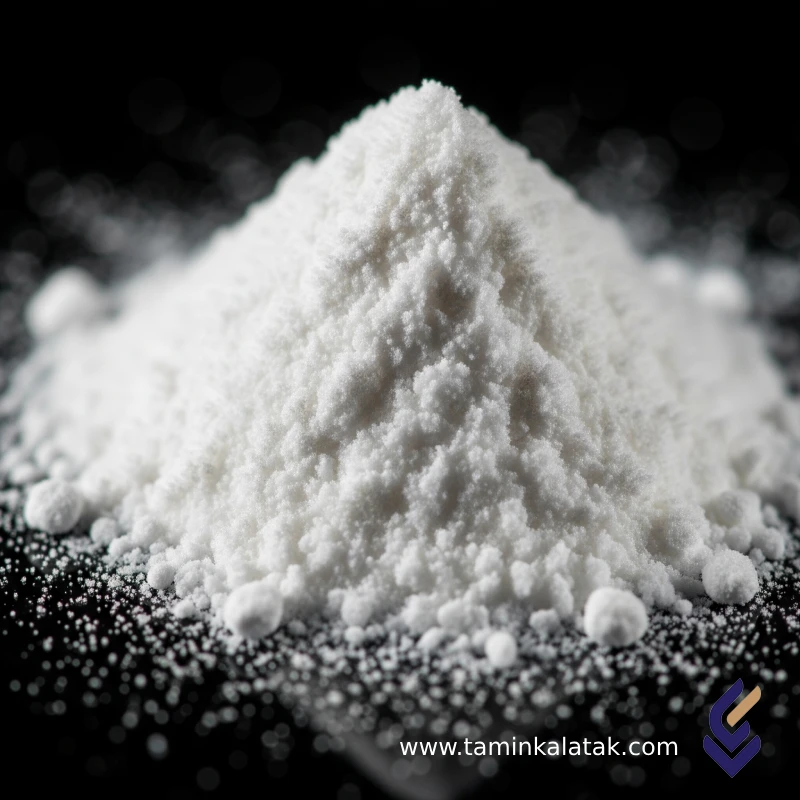Ascorbic acid
Ascorbic Acid (commonly known as Vitamin C) is an organic compound with the chemical formula C₆H₈O₆. This water-soluble vitamin appears as a white or slightly yellow crystalline solid with a sour taste. Ascorbic acid is an essential nutrient for humans and some animals, as the body cannot synthesize it and must obtain it through diet or supplements.
Structure
The structure of ascorbic acid features a five-membered lactone ring (furan ring) containing a ketone group and four hydroxyl (-OH) groups. This structure gives the molecule its acidic property (due to the enolic group in the ring) and strong antioxidant activity. The presence of double bonds and hydroxyl groups makes it a biologically active compound.
Properties
-
Physical state: White or slightly yellow crystalline solid
-
Odor: Odorless
-
Taste: Sour
-
Solubility: Fully soluble in water, moderately soluble in alcohol; insoluble in oils and fats
-
Melting point: Around 190°C (decomposes upon melting)
-
Stability: Unstable in the presence of heat, light, oxygen, and heavy metals; it oxidizes easily. This instability poses a major challenge in storing and processing vitamin C-containing foods
-
Antioxidant property: A powerful antioxidant due to its ability to donate electrons and neutralize free radicals
Applications
Nutritional & Pharmaceutical Use:
-
Treatment and prevention of scurvy (vitamin C deficiency)
-
Supports the immune system and helps fight infections
-
Promotes wound healing and tissue repair
-
Functions as an antioxidant, protecting cells from oxidative damage
Food Industry:
-
Food additive (E300): Used as an antioxidant and preservative to prevent oxidation, discoloration, and spoilage (e.g., in dried fruits, juices, processed meats, and baked goods)
-
Fortification agent: Increases vitamin C content in products like juices, breakfast cereals, and infant formulas
-
Flour improver: Enhances dough quality and bread volume in baking
Cosmetic & Skincare Industry:
-
Used as an antioxidant in skincare to reduce damage caused by UV radiation and pollution
-
Aids in collagen production and helps reduce wrinkles
-
Acts as a skin brightener and reduces dark spots
Other Uses:
-
Photography: In certain photographic film development processes
-
Water Treatment: Occasionally used to remove chlorine from water
Advantages
-
Powerful Antioxidant: Plays a key role in protecting cells against oxidative stress and free radicals
-
Boosts Immunity: Supports the body’s immune defenses
-
Collagen Synthesis: Essential for the health of skin, bones, cartilage, gums, and blood vessels
-
Improves Iron Absorption: Enhances the absorption of non-heme iron from plant sources
-
Anti-inflammatory Properties: May help reduce inflammation
-
Safe and Non-Toxic (at normal doses): Generally safe with minimal side effects at recommended doses
-
Natural Preservative: A good natural alternative to synthetic preservatives in food
Disadvantages
-
Instability: Easily degrades under heat, light, oxygen, and in the presence of metals, making it hard to preserve in food and supplements
-
Sensitivity to High Doses: Excessive intake (mega doses) may cause side effects such as diarrhea, nausea, abdominal cramps, and increased risk of kidney stones in susceptible individuals
-
Copper Interaction: In the presence of copper, it can act as a pro-oxidant (generating free radicals), though this is less likely under normal biological conditions
-
Low pH: Its acidity can irritate people with sensitive stomachs, although buffered forms are available
-
Laxative Effect: High doses may have a mild laxative effect in some individuals
Applications
| Applications | , , , , , , |
|---|
Ascorbic acid
| Chemical name | Chemical formula | CAS number | Grade | Vapor pressure | Physical appearance | Density (at 20°C) | Melting point | Solubility in water |
|---|---|---|---|---|---|---|---|---|
| L-Ascorbic Acid | C₆H₈O₆ | 50-81-7 | Analytical Grade, USP, Food Grade | (Practically negligible) | White or yellowish crystalline solid | 1.65 g/cm³ | 190–192°C (with decomposition) | 330 g/l at 20°C (very soluble) |







